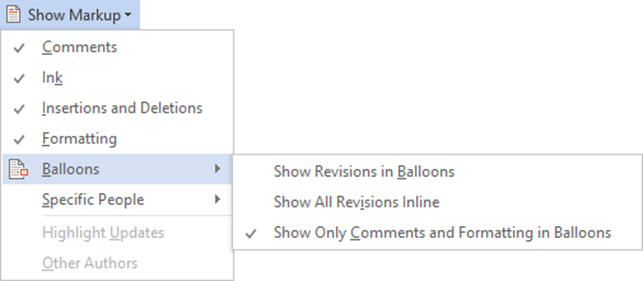New book: Microsoft Word 2013 Step by Step
 We are happy to announce that Microsoft Word 2013 Step By Step (ISBN 9780735669123), by Joan Lambert and Joyce Cox is now available for purchase here or here. To support an independent bookstore, order here.
We are happy to announce that Microsoft Word 2013 Step By Step (ISBN 9780735669123), by Joan Lambert and Joyce Cox is now available for purchase here or here. To support an independent bookstore, order here.
A free PDF of this book’s sample chapters are available to download from the Microsoft Download Center here.
Here is an excerpt from Chapter 15, Collaborate on documents:
Tracking and managing document changes
When two or more people collaborate on a document, one person usually creates and “owns” the document and the others review it, adding or revising content to make it more accurate, logical, or readable. In Word, reviewers can turn on the Track Changes feature so that the revisions they make to the document are recorded without the original text being lost. (Note that turning on Track Changes affects only the active document, not any other documents that might also be open.)
To turn on Track Changes, you click the Track Changes button in the Tracking group on the Review tab. You then edit the text as usual.
TIP If you want to know whether Track Changes is turned on when the Review tab is not displayed, right-click the status bar and then click Track Changes on the Customize Status Bar menu. Word then adds a Track Changes button to the status bar that you can click to turn the feature on and off.
By default, your revisions appear in a different color from the original text, as follows:
▪ Insertions are inserted in the text in your assigned color. Insertions are underlined, and deletions are crossed out (the formatting is called strikethrough).
▪ Formatting changes appear in balloons in the markup area.
▪ All changes are marked in the left margin by a vertical line.
▪ You can display deletions in balloons instead of in the text, and you can display formatting changes in the text instead of in balloons. Simply click the Show Markup button in the Tracking group on the Review tab, click Balloons, and then click the options you want.
You can specify whether you want revisions to be displayed in the text or in balloons.
TIP The colors used for revisions are controlled by the settings in the Track Changes Options dialog box, which you can display by clicking the Tracking dialog box launcher.
You can display a ScreenTip identifying the name of the reviewer who made a specific change, and when the change was made, by pointing to a revision or balloon. The reviewer name is taken from the user information stored with the user account. You can change the stored user information for your user account from the Word Options dialog box, which you can open either from the Backstage view or by clicking the Tracking dialog box launcher and clicking Change User Name in the Track Changes Options dialog box.
TROUBLESHOOTING If you’re signed in to Word with a Microsoft account, Word tracks revisions by the name associated with your Microsoft account. Changing your user information affects revision tracking only when you aren’t signed in with a Microsoft account.
By using the commands available on the Review tab, you can work with revisions in the following ways:
▪ To track changes without showing them on the screen, hide the revisions by clicking the Display for Review arrow in the Tracking group and clicking No Markup in the list. To display the revisions again, click All Markup in the Display for Review list. You can also display the original version, with or without revisions.
▪ When revisions are visible in the document, select which types of revisions you want to display from the Show Markup list in the Tracking group—for example, you can display only comments or only insertions and deletions. You can also display or hide the revisions of specific reviewers from this list.
▪ Move forward or backward from one revision or comment to another by clicking the Next or Previous button in the Changes group.
▪ Incorporate a selected change into the document and move to the next change by clicking the Accept button in the Changes group. Click the Reject button to remove the selected change, restore the original text, and move to the next change.
TIP You can also right-click the change and then click Accept or Reject.
▪ Accept or reject all the changes in a block of text, such as a paragraph, by selecting the block and clicking the Accept or Reject button.
▪ Accept all the changes in the document by clicking the Accept arrow and then clicking Accept All Changes. Reject all the changes at once by clicking the Reject arrow and then clicking Reject All Changes.
▪ Accept or reject only certain types of changes or changes from a specific reviewer by displaying only the changes you want to accept or reject, clicking the Accept or Reject arrow, and then clicking Accept All Changes Shown or Reject All Changes Shown in the list.
In this exercise, you’ll turn on change tracking, edit the document, and accept and reject changes. SET UP You need the CompetitiveAnalysisB document located in the Chapter15 practice file folder to complete this exercise. Open the document, and then follow the steps.

1. On the Review tab, in the Tracking group, click the Track Changes button (not its arrow). Notice that the button color changes to blue to indicate that Track Changes is turned on. Any changes that you make now will be indicated in the document as revisions.
KEYBOARD SHORTCUT Press Ctrl+Shift+E to turn on change tracking. For more information about keyboard shortcuts, see “Keyboard shortcuts” at the end of this book.
2. In the Display for Review list, click All Markup. In the Show Markup list, click Balloons, and ensure that Show Only Comments and Formatting in Balloons is selected.
3. Display the table. In the Prices column of the Fabrikam row, in the phrase Some much lower, double-click the word much, and then press the Delete key. Notice that Word indicates with strikethrough formatting that you deleted the word.
4. In the Service column of the Fabrikam row, position the insertion point after the word Adequate, press the Spacebar, and then enter but slow to insert the new text in the same color as the deletion.
5. In the Quality column of the Northwind Traders row, select the word Poor, and then enter Substandard to show this one change as both a deletion and an insertion. Then point to the deleted word Poor to display an informative ScreenTip.

A vertical line in the left margin draws your attention to revisions. Revision ScreenTips display information about the change.
Let’s look at a few other views of tracked changes.
6. In the Tracking group, click Show Markup, click Balloons, and then click Show Revisions in Balloons to remove the deletions from the text and display them in the right margin.

The text is less cluttered if you display deletions in balloons.
7. In the Tracking group, click Show Markup, click Balloons, and then click Show All Revisions Inline to restore the inline revision indicators and remove the balloons.
8. In the Tracking group, in the Display for Review list, click No Markup to hide the revisions and display the document as it would appear if all the changes were accepted.
9. In the Display for Review list, click Simple Markup to indicate the presence of tracked changes only by displaying user-specific color-coded vertical lines in the left margin.
Now we’ll review and process the tracked changes.
10. In the Display for Review list, click All Markup to redisplay the tracked changes. Then press Ctrl+Home to move to the beginning of the document.
11. In the Changes group, click the Next button to select the first change in the document—the deleted word much. Then click the Accept button (not its arrow) to accept the change, remove the revision and associated balloon, and move to the next change (but slow).
12. In the Changes group, click the Reject button (not its arrow) to remove the inserted text, and because there are no more changes in this row of the table, to also remove the adjacent vertical bar from the left margin, and then move to the next change (Substandard).
TIP You can click the Accept or Reject arrow to display a menu of actions associated with the command, including not moving to the next change, processing all changes of that type, and turning off change tracking after processing the change.
13. In the Changes group, click the Accept button to implement the deletion, and then click the same button again to implement the insertion. Word then displays a message box telling you that there are no more changes in the document.
14. Click OK to close the message box.
15. In the Tracking group, click the Track Changes button to stop tracking changes made to the active document.

